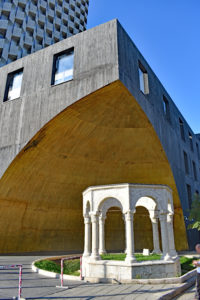Having spent a half-day sightseeing in Albania’s capital, Tirana, with our guide (“Sightseeing Part 1”:https://www.silvertraveladvisor.com/review/place/202125-tirana-sightseeing-in-tirana-part-1?helpful=1), we had more time to explore the city.
From our balcony at the “Oxford Hotel”:https://www.silvertraveladvisor.com/review/accommodation/202008-review-oxford-hotel, it was hard to miss a tall unusually clad building which on closer inspection, turned out to be the PLAZA TIRANO HOTEL. However, the real feature was how the giant hotel has been built with a corner missing to protect the TYRBE (or Tomb) of KAPLLAN PASHA. Just across the way, in a small park was the statue of the UNKNOWN PARTISAN which towered over the smaller statue of SULEJAMIN PASHA MULLETI the founder of the city.
THE PYRAMID, an iconic tall triangular building, opened in 1988 as the Enver Hoxha Museum following his death three years earlier. It was designed by Hoxha’s daughter Pranvera Hoxha, who was also the architect behind “Kruja Castle”:https://www.silvertraveladvisor.com/review/attraction/200217-review-kruja-castle. Following the collapse of Communism, it was changed to a conference centre and exhibition venue but is now defunct: the glass is broken, it’s covered in graffiti and through the grills rubbish abounded on the inside. Apparently, plans are afoot to either demolish or refurbish it. A bridge led up to it from one direction with a large brass bell known as the Peace Bell. It was made in memorial to those who died in 1997 following the collapse of the Pyramid Investment Scheme with the brass coming from thousands of bullets spent that year. Although we saw several fit youths climbing up to the top of the pyramid, we weren’t tempted to join them.
Very near out hotel was a pedestrianised street and the CASTLE RUINS, now converted into an upmarket area with small boutiques, galleries, bars and restaurants.
THE FRIENDSHIP MONUMENT consisted of three concrete columns supporting a circular roof made up of red, white, blue and black circles, the colours of the Kuwait flag. It was erected in 2016 to commemorate “the everlasting friendship between the people of Albania and the people of Kuwait”.
On Boulevard Dëshmorët e Kombit (Boulevard of the Martyrs of the Nation), RINIA PARK was being refurbished and the former HOTEL DAJATI was being transformed into a bank. During the communist period this hotel was where the country’s limited number of foreign visitors stayed: ordinary Albanians were not allowed through the door.
The current PARLIAMENT BUILDINGS, where a demonstration was taking place, was the former meeting place of the communist party’s Central Committee. A tunnel was said to lead from here directly to Enver Hoxha’s house 270m away on Rruga Ismail Qemali. This street, and those in a square mile around it, was known as The Block, and was off limits to ordinary Albanians. We tried to find the house, which we think we did, but the presence of what appeared to be plain-clothed security men with earpieces stopped us investigating too much. Across the road from Parliament, CHECKPOINT commemorated Albania’s isolation under communism. In the open space we found (1) a fragment of the Berlin Wall, (2) a bunker, inscribed TRIII 1976, which guarded the main entrance to the segregated residential block where Enver Hoxha and the most senior communist officials lived between 1945 and 1991 and (3) part of the concrete mineshaft supports from Spaçi, a forced labour camp and the only one used solely for political prisoners from 1968 to 1990.
MOTHER THERESA SQUARE, a large rather uninspiring, open area, had the Academy of Arts on one side and the Archaeological Museum on the other, with the University nearby. However, we skirted the students and continued on to the GRAND PARK or LAKE PARK with its various memorials. The first was the graveyard of German soldiers who died in Albania during World War II, and then a little further were the graves and busts of a number of highly influential Albanians. We then reached the British Memorial Cemetery commemorating the 46 British and Commonwealth soldiers and airmen, who again died during World War II. However, they are not buried here as the remains were removed during 1946 and reburied in an unknown place. Interestingly, facing the opposite way and slightly apart from the line of headstones was, what looked to be, a recent burial. As the area was roped off, we couldn’t make out the inscription, but a photograph later revealed it bore the date 27 October 1944 and was dedicated to the crew of the Halifax JP244 Royal Air Force. Having stopped for a well-earned drink in a café, we followed trails around the huge park and lake. The walking was good and relatively flat but unfortunately there was a lack of information boards with the ‘you are here dot’ and as our map didn’t extend that far, we tried not to get lost.
Back out of the park we found KAFE KOMETTI, said to be furnished and decorated with original items from 1970s Albanian households and it was indeed like ‘Nan’s living room’. Whilst we hoped for refreshments, little English was spoken, and as it wasn’t very welcoming we left and headed back to our “hotel”:https://www.silvertraveladvisor.com/review/accommodation/202008-review-oxford-hotel.
See also “Sightseeing in Tirana – Part 3”:https://www.silvertraveladvisor.com/review/place/202169.















